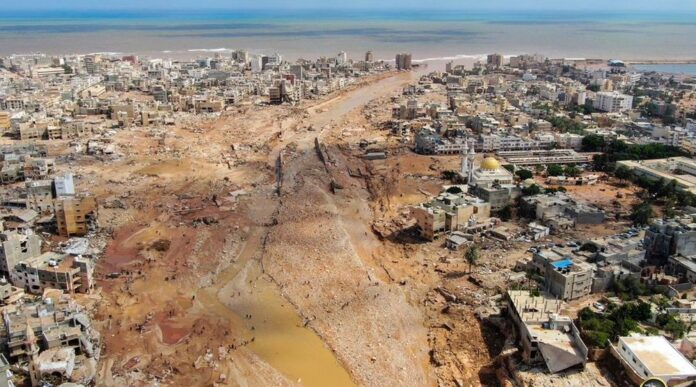What Happened?
On September 11th, northeastern Libya was struck by the Mediterranean Storm Daniel. The coastal city of Derna became the center of a catastrophic flood when two of its dams broke due to the storm, dumping an estimated 30 million cubic meters of water in the city [1]. This resulted in the widespread devastation of entire communities in coastal towns being carried into the sea.
This disaster has violently claimed approximately 11,300 lives, with more than 10,000 people still missing, and over 40,000 people forced to flee the region [2]. Reports from the ground suggest many of these victims remain shelterless, without access to necessities of food, clean water or power, with a looming risk of an escalation in water-born infectious diseases proliferating among the survivors living near stagnant flood water [2].
Flood experts have observed that the recent exceptionally heavy rainfall across the Mediterranean was worsened by climate change, thus amplifying Storm Daniel [3]. While the evident devastation is severe, the full extent of destruction will only become apparent once relief groups can reach areas currently inaccessible due to destroyed bridges and roads [6].
The residents of Derna are tragic victims of a deadly interplay between human-caused climate change and ongoing proxy wars led by actors with a vested interest in the region, while also benefiting from the country’s rich resources including massive oil reserves and a multi-billion dollar war industry that thrives on conflict. Derna’s front-line community has paid an insurmountable price for an ecological crisis made worse due to wars and now copes with finding the strength to pick up what little is left.
Derna’s Vulnerability to Floods
Derna is a port city on the Mediterranean coast, located in Wadi Derna, a river valley in northeastern Libya surrounded by the Akhdar Mountains [4]. It was no secret that this town remained highly vulnerable to floods given its location. To protect the city from inundation, two dams, Abu Mansour and Derna, were built in 1970 above the valley, each holding 22.5 million cubic meters and 1.5 million cubic meters of water respectively [1].
Despite many warnings of an imminent risk of disaster, the dams had not been maintained for years, leading to their eventual burst and killing thousands [5]. Although a Turkish company was contracted between 2007 and 2012 to repair these dams, it was later found that the work could not be completed amidst security concerns. In 2011 NATO led a military invasion of Libya, bombarding 9,600 strikes on various targets, and removing its former ruler, Colonel Muammar al-Gaddafi, which then resulted in the outbreak of civil wars and continued political instability [5].
(New York Times, 2023)
War & Political Divide Fuelling Climate Vulnerability
Libya’s current disaster has been intensified by the convergence of climate change and the repercussions of a bloody civil war, set in motion by NATO supporting uprising against Colonel Gaddafi, in particular its bombardment of the country’s key government institutions, resulting in the ongoing political divide that is fueling a governance crisis in the country [3] [11].
It has been more than a decade since NATO invaded Libya, erupting a civil war that has since grappled the country with violence amidst a deep political divide and a power struggle.
The severity of Derna’s floods and its subsequent devastation has been driven by an amalgamation of civil war characterized by an ongoing political divide and a worsening climate crisis [11]. With key government institutions not functioning, there were no steps taken to effectively implement disaster preparedness, nor was there a functioning storm warning mechanism in place issuing clear communication to vulnerable populations, ensuring timely and mandatory evacuation [5].
This past decade in Libya has been mired with constant civil wars that have claimed many innocent lives. On top of braving the burdens of civil unrest, Libyan people are now front-line to the violence of climate change.
Evidence suggests that the communities engulfed in war and armed conflict are particularly vulnerable to the impacts of climate change due to the strained adaptive capacity of its people, systems and institutions that are struggling to cope with the direct impacts of the conflict [12].
Libya’s climate vulnerability is compounded by NATO’s damaging legacy, its bombardment of the country, and the subsequent civil wars still ravaging the country.
Climate Action Must Include Divesting from War
NATO’s overthrowing of Gaddafi’s 42-year-long government led to years of political instability that persists to this day. Experts provide evidence of the presumed interests of several foreign elements in the region, making Libya an active ground of proxy wars with the involvement of various countries [13]. At the center of this ongoing conflict are the Libyan people who are in dire need of political stability, and particularly attention to building climate resilience to avoid disasters like the devastating floods in Derna.
While governments around the world take steps towards making climate action their priority, the war industry continues to bloom despite its evident destructive legacy and heavy carbon footprint.
The global war industry is a lucrative multi-billion dollar enterprise that reaps high volumes of profits. However, its monetary gains are not the only factor driving its success—the arms business also serves as a key instrument leveraged by governments around the world to steer foreign policy in preferred directions [7].
Some experts claim that this industry is particularly instrumental in Washington’s foreign policy, evidenced by the fact that it is the largest exporter of arms in the world. The U.S., a founding NATO member, provided over 40% of the world’s weapons in 2021, and its share has consistently increased in the last few years [7]. Together with the U.S., other major exporters of weapons include France, Russia and Italy—predominantly nations of the Global North.
(Council on Foreign Relations, 2023)
The war industry thrives on destruction with conflict at the core of its business model: conflict creates more demand for profitable arms sales, which in turn causes more destruction leading to more conflict, and the vicious cycle continues.
During the Libyan civil unrest, U.S. arms have made their way into the hands of militia groups fighting for power [9]. Similarly, arms from other key global exporters of weapons, such as Russia and France, have also been found in Libya [9] [10].
Not only does war exacerbate the impacts of climate change by fueling vulnerability and undermining resilience to withstand threats of extreme weather events, but it also leaves behind a significant carbon footprint. The U.S. military is the single largest institutional consumer of oil, and therefore, the biggest institutional source of greenhouse gas emissions in the world [8].
Divesting from the multi-billion dollar military complex is a necessary urgent step for combating climate change. Instead of continuing to invest in a destructive industry that also contributes significantly to carbon emissions, the Global North, particularly the U.S., must start investing in just and equitable climate solutions that aim to provide dignified lives to all humans.
References
- AP News. (2023). Libya was mired in chaos and corruption. For years, warnings the Derna dams may burst went unheeded. Article. https://apnews.com/article/libya-derna-dams-collapse-floods-corruption-neglect-chaos-45f76d2ac76be634865539a27b518ada#:~:text=The%20warnings%20came%20true%20in,entire%20neighborhoods%20out%20to%20sea
- France 24. (2023). UN says death toll at least 11,300 in Libya’s flood-hit Derna. Article. https://www.france24.com/en/live-news/20230917-aid-arrives-as-libya-copes-with-flooding-aftermath
- Nature. (2023). Libya floods: how climate change intensified the death and devastation. Article https://www.nature.com/articles/d41586-023-02899-6#:~:text=Climate%20change%2C%20civil%20war%20and,worst%20flooding%20ever%2C%20researchers%20say.
- Encyclopedia Britannica. (2023). Derna, Libya. https://www.britannica.com/place/Darnah
- Reuters. (2023). Insight: ‘They knew’ – fury of Libyans that warnings went unheeded before flood. Article. https://www.reuters.com/world/africa/they-knew-fury-libyans-that-warnings-went-unheeded-before-flood-2023-09-15/
- Center for Disaster Philanthropy. (2023). 2023 Libya Floods. https://disasterphilanthropy.org/disasters/2023-libya-floods/
- Council on Foreign Relations. (2022). The Cost of the US Arms Trade. Podcast. https://www.cfr.org/podcasts/cost-us-arms-trade
- Watson Institute, International and Public Affairs, Brown University. (2023). Pentagon Fuel Use, Climate Change, And The Costs Of War. Website. https://watson.brown.edu/costsofwar/papers/ClimateChangeandCostofWar
- The New York Times. (2019). American Missiles Found in Libyan Rebel Compound. Article. https://www.nytimes.com/2019/06/28/world/africa/libya-american-missiles.html
- EU Observer. (2020). Why do EU arms end up in Libya despite UN ban? Article. https://euobserver.com/world/147256
- Tricontinental Institute. (2023). NATO Destroyed Libya in 2011; Storm Daniel Came to Sweep Up the Remains: The Thirty-Eighth Newsletter. Article. https://thetricontinental.org/newsletterissue/libya-floods/
- International Committee of the Red Cross. (2020). When rain turns to dust. Report. https://www.icrc.org/en/publication/4487-when-rain-turns-dust
- United States Institute of Peace. (2020). Four Things to Know About Libya’s Conflict and Foreign Interference. Article. https://www.usip.org/publications/2020/07/four-things-know-about-libyas-conflict-and-foreign-interference



